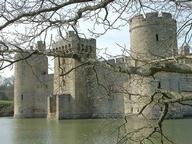Quiz Answer Key and Fun Facts
1. At the eastern end of the South Downs, a large chalk headland meets the sea between the Birling Gap and Eastbourne. Wonderful views maybe had from this chalk cliff, which exceeds five hundred feet in height above the sea. What is it called?
2. The "Long Man of Wilmington" is a large chalk outline of a humanoid figure. It is carved into a hill close to the village of Wilmington, but on the side of which hill?
3. One of the legends about the "Long Man of Wilmington" is that it is the outline of a dead giant. It is claimed that a boulder thrown by another giant killed him. On which hill did his alleged assailant stand?
4. As the South Downs Way heads west towards Lewes and the River Ouse, a separate hill appears to the north. Overlooking the village of Glynde, site of the annual festival of Glyndbourne, this hill was once topped by a large hill fort. Which hill is this?
5. To the northwest of Lewes is the site of the "Battle of Lewes" which occurred in 1264. The former Lewes racecourse was also situated here on the slopes above Lewes Prison. Which of these hills, which also forms part of the title of former MP Tim Renton, can be found here?
6. A very popular hill stands above a village with which it shares its name. Its popularity is probably related to the fact that it can be ascended by bus or car thus sparing weary legs. Where is the highest point of land in East Sussex?
7. This hill has been used for Bronze Age burials, as an Iron Age hill fort, and was the site of a Roman temple. Alleged to have been created when the devil tried to dig a ditch and flood Sussex, the hill has a reputation for spooky and occult occurrences. In 1760 a crown of beech trees was planted on it. Which place on the South Downs Way have we reached?
8. To the west of Devils Duke, along the South Downs Way, is a hill topped with transmitter masts. For a period of time during the Cold War it was a radar station manned by the RAF. Below the hill on the outskirts of Shoreham was the attendant RAF base that was named after the hill. Which hill is this?
9. The South Downs Way is a popular and well-known long distance footpath, but even these have to give way to main roads. As the path approaches the A24 from east to west a diversion to a bridge at Washington is offered. Those brave souls who cross the A24 without the diversion find themselves climbing up which hill?
10. To the south west of Pulborough lie the remains of a Roman villa found in 1811. The villa is known by the name of the nearest village, which in turn is also the name of the hill to the south. It is crossed by the South Downs Way and has the feature "Toby's Stone" on its eastern flank. Name that hill!
11. In the 1980s William Horwood wrote a series of stories about moles. The titles in the series include the name of which of the South Downs, which according to Kipling "Knew Old England before the Crown."?
12. According to the figures of the Ordnance Survey, two hills share the title of third highest point on the South Downs at 248m. Which of the following is one of them?
13. The 'Cathedral of the Downs' is a title claimed by more than one church. In 1947 one such church, St Peters was dismantled a mere 100 years after being built, having been condemned as unsafe. The village to which this church belonged shares its name with the nearby hill. Which of the following is it?
14. We come to a hill listed by Kipling as knowing "Old England before the flood." The hill itself does not appear on the 1:25,000 Ordnance Survey maps but a farm of the same name lies en route of the South Downs Way on the northern slopes of West Harting Down and an unnamed hill. What is the name of the farm and missing hill?
15. The highest point of the South Downs lies in Hampshire near the town of Petersfield. Which hill is this?
Source: Author
paper_aero
This quiz was reviewed by FunTrivia editor
Exit10 before going online.
Any errors found in FunTrivia content are routinely corrected through our feedback system.

